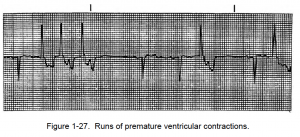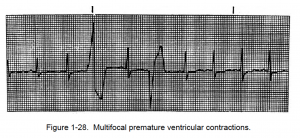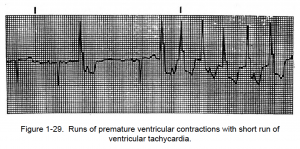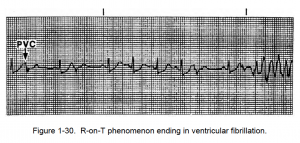b. Premature Ventricular Contractions. Examples are shown in figures 1-26 through 1-30.
(1) Analysis. A premature ventricular contraction (PVC) is a single ectopic (heartbeat arising from a place other than the SA node) caused by irritable focus in the ventricles.
The heartbeat comes earlier than expected and interrupts the regularity of the underlying rhythm of the heart.
The heartbeat rate is determined by the underlying heartbeat rhythm, PVCs not being included in the rate. P waves will not come before an ectopic heartbeat; however, P waves may be seen near a premature ventricular contraction. Since the heartbeat comes from a lower focus, there will be no P-R interval.
The QRS complex will be wide and bizarre (at least 0.12 or more of a second). The T wave is usually in the opposite direction from the R wave.
Premature ventricular contractions may be quite serious, particularly in certain combinations and in the wake of acute myocardial infarction. Dangerous signs include frequent PVCs, runs of PVCs, multifocal PVCs, and the R-on-T phenomenon. In a perfectly healthy person, PVCs may not always be considered an abnormality; however, if the casualty is experiencing acute myocardial infarction, PVCs must be treated instantly.
![1-11. VENTRICULAR ARRHYTHMIAS: B. PVC'S 1 ECG showing a ventricular premature contraction.[ Source – Wikipedia, Author – James Heilman, MD].](https://brooksidepress.org/ecg/wp-content/uploads/2015/11/PVC-300x149.jpg)
Wikipedia, Author – James Heilman, MD].
(2) Characteristics. The following are characteristic of premature ventricular contractions.
(a) A compensatory pause usually follows a PVC. The distance between the R wave of complex preceding the PVC and the R wave of complex following the PVC is exactly twice the R-R interval of underlying rhythm.
(b) The PVC does not have to have a compensatory pause. The beat can be “interpolated” between two sinus beats without interrupting the underlying rhythm.
(c) Premature ventricular contractions indicate myocardial irritability. The frequency of PVCs suggests the degree of myocardial irritability.
(d) Premature ventricular contractions are considered unifocal if they all originate from a single ventricular focus and have similar configurations.
(e) Premature ventricular contractions are considered multifocal if they original from many different points and have different configurations.
(f) If a PVC occurs during a vulnerable (relative refractory) phase of the cardiac cycle, the PVC can produce lethal, repetitive arrhythmias. A PVC that falls on the downslope of a T wave is referred to as “R-on-T” phenomenon and is considered very dangerous.
(g) With increasing irritability, PVCs can occur in pairs called couplets or in runs of three or more consecutive ectopics (ectopic heartbeat originating from a place other than the SA node).
(h) Premature ventricular contractions frequently occur in patterns such as the following:
1 Bigeminy–a PVC every other heartbeat.
2 Trigeminy–a PVC every third beat.
3 Quadrigeminy–a PVC every fourth beat.
NOTE: Bigeminy, trigeminy, and quadrigeminy can also describe patterns of premature atrial contractions (PACS) and premature junctional contractions (PJCs).





